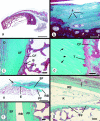Where tendons and ligaments meet bone: attachment sites ('entheses') in relation to exercise and/or mechanical load
- PMID: 16637873
- PMCID: PMC2100202
- DOI: 10.1111/j.1469-7580.2006.00540.x
Where tendons and ligaments meet bone: attachment sites ('entheses') in relation to exercise and/or mechanical load
Abstract
Entheses (insertion sites, osteotendinous junctions, osteoligamentous junctions) are sites of stress concentration at the region where tendons and ligaments attach to bone. Consequently, they are commonly subject to overuse injuries (enthesopathies) that are well documented in a number of sports. In this review, we focus on the structure-function correlations of entheses on both the hard and the soft tissue sides of the junction. Particular attention is paid to mechanical factors that influence form and function and thus to exploring the relationship between entheses and exercise. The molecular parameters indicative of adaptation to mechanical stress are evaluated, and the basis on which entheses are classified is explained. The application of the 'enthesis organ' concept (a collection of tissues adjacent to the enthesis itself, which jointly serve the common function of stress dissipation) to understanding enthesopathies is considered and novel roles of adipose tissue at entheses are reviewed. A distinction is made between different locations of fat at entheses, and possible functions include space-filling and proprioception. The basic anchorage role of entheses is considered in detail and comparisons are explored between entheses and other biological 'anchorage' sites. The ability of entheses for self-repair is emphasized and a range of enthesopathies common in sport are reviewed (e.g. tennis elbow, golfer's elbow, jumper's knee, plantar fasciitis and Achilles insertional tendinopathies). Attention is drawn to the degenerative, rather than inflammatory, nature of most enthesopathies in sport. The biomechanical factors contributing to the development of enthesopathies are reviewed and the importance of considering the muscle-tendon-bone unit as a whole is recognized. Bony spur formation is assessed in relation to other changes at entheses which parallel those in osteoarthritic synovial joints.
Figures




Similar articles
-
Structure-function relationships of entheses in relation to mechanical load and exercise.Scand J Med Sci Sports. 2007 Aug;17(4):303-15. doi: 10.1111/j.1600-0838.2007.00689.x. Epub 2007 May 9. Scand J Med Sci Sports. 2007. PMID: 17490450 Review.
-
The skeletal attachment of tendons--tendon "entheses".Comp Biochem Physiol A Mol Integr Physiol. 2002 Dec;133(4):931-45. doi: 10.1016/s1095-6433(02)00138-1. Comp Biochem Physiol A Mol Integr Physiol. 2002. PMID: 12485684 Review.
-
Adipose tissue at entheses: the rheumatological implications of its distribution. A potential site of pain and stress dissipation?Ann Rheum Dis. 2004 Dec;63(12):1549-55. doi: 10.1136/ard.2003.019182. Ann Rheum Dis. 2004. PMID: 15547077 Free PMC article.
-
Fibrocartilage in tendons and ligaments--an adaptation to compressive load.J Anat. 1998 Nov;193 ( Pt 4)(Pt 4):481-94. doi: 10.1046/j.1469-7580.1998.19340481.x. J Anat. 1998. PMID: 10029181 Free PMC article. Review.
-
The enthesis organ concept and its relevance to the spondyloarthropathies.Adv Exp Med Biol. 2009;649:57-70. doi: 10.1007/978-1-4419-0298-6_4. Adv Exp Med Biol. 2009. PMID: 19731620 Review.
Cited by
-
Differentiating rheumatoid and psoriatic arthritis: a systematic analysis of high-resolution magnetic resonance imaging features-preliminary findings.Skeletal Radiol. 2021 Mar;50(3):531-541. doi: 10.1007/s00256-020-03588-5. Epub 2020 Aug 26. Skeletal Radiol. 2021. PMID: 32845377 Free PMC article.
-
PTHrP regulates the modeling of cortical bone surfaces at fibrous insertion sites during growth.J Bone Miner Res. 2013 Mar;28(3):598-607. doi: 10.1002/jbmr.1801. J Bone Miner Res. 2013. PMID: 23109045 Free PMC article.
-
Anatomy of the Achilles tendon-A pictorial review.Orthopadie (Heidelb). 2024 Oct;53(10):721-730. doi: 10.1007/s00132-024-04555-x. Epub 2024 Aug 30. Orthopadie (Heidelb). 2024. PMID: 39212710 Review. English.
-
Relative effectiveness and adverse effects of cervical manipulation, mobilisation and the activator instrument in patients with sub-acute non-specific neck pain: results from a stopped randomised trial.Chiropr Osteopat. 2010 Jul 9;18:20. doi: 10.1186/1746-1340-18-20. Chiropr Osteopat. 2010. PMID: 20618936 Free PMC article.
-
Anatomy and histomorphology of the flexor digitorum profundus enthesis: functional implications for tissue engineering and surgery.BMC Musculoskelet Disord. 2021 Dec 10;22(1):1032. doi: 10.1186/s12891-021-04922-1. BMC Musculoskelet Disord. 2021. PMID: 34893040 Free PMC article.
References
-
- Abreu MR, Chung CB, Mendes L, Mohana-Borges A, Trudell D, Resnick D. Plantar calcaneal enthesophytes: new observations regarding sites of origin based on radiographic, MR imaging, anatomic, and paleopathologic analysis. Skeletal Radiol. 2003;32:13–21. - PubMed
-
- Adams CMW, Bayliss OB, Baker RWR, Abdulla YH, Huntercraig CJ. Lipid deposits in aging human arteries, tendons, and fascia. Atherosclerosis. 1974;19:429–440. - PubMed
-
- Andriacchi TP, Birac D. Functional testing in the anterior cruciate ligament-deficient knee. Clin Orthop Relat Res. 1993;288:40–47. - PubMed
-
- Aoki M, Oguma H, Fukushima S, Ishii S, Ohtani S, Murakami G. Fibrous connection to bone after immediate repair of the canine infraspinatus: the most effective bony surface for tendon attachment. J Shoulder Elbow Surg. 2001;10:123–128. - PubMed
-
- Bell E, Gosline J. Mechanical design of mussel byssus: material yield enhances attachment strength. J Exp Biol. 1996;199:1005–1017. - PubMed
Publication types
MeSH terms
LinkOut - more resources
Full Text Sources
Other Literature Sources
Medical

